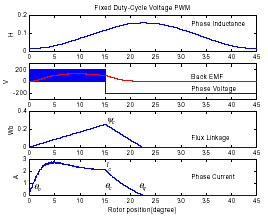







How to Control a Switched Reluctance Motor?
When operating an SR motor, it is necessary to know the rotor position so that the motor is energised to produce useful positive torque (i.e. at half the rotor pole pitch). SR motor can be controlled either by regulating or controlling the phase voltage or the phase current. At low speed region (upto base speed), PWM technique can be used to control the phase voltage and phase current. Above the base speed, single voltage pulse technique is used to regulate the phase current instead of controlling the phase current. This is due to significant back EMF generated in the motor and with limited DC supply voltage, current control with PWM technique is not achievable. The voltage, current, flux linkage and inductance waveforms for both the PWM and single pulse techniques are shown in Figure 8 and 9.
